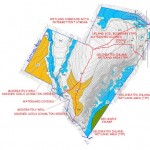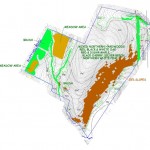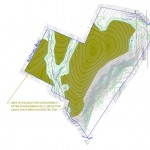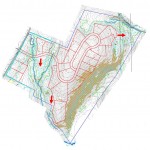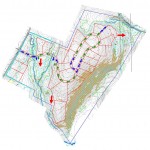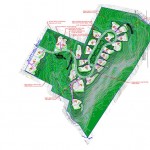Low Impact Sustainable Development (LISD) is expanded version of Low Impact Development (LID). The focus of LID is on stormwater management. The concept of LID was pioneered by Larry Coffman of Princes George County, Maryland to address primarily water quality issues of runoff entering Chesapeake Bay. Runoff from both developing areas as well as agricultural uses within the immediate watershed of Chesapeake Bay were discharging significant nutrient loads as well as other pollutants into the Chesapeake Bay. The pollutants in the runoff, particularly nitrogen and phosphorous were adversely affecting the water quality in the Bay, which in turn affected the aquatic species in the bay, which much of the local economy depends on.
The goal of LID is to mimic pre-development hydrologic conditions for small frequent rainfall events and also to filter the runoff to remove as much as the pollutant load as possible from the runoff prior to discharging to a wetland or watercourse. Research has documented that between 85 to 90 percent of our annual rainfall occur as 1″ or less within a 24 hour period. The 1″ rainfall event is known at the 90% storm event is the basis of LID stormwater designs.
A major hydrologic goal of LID and LISD is to maintain natural infiltration rates by soil type for post-development conditions for the 90% rainfall event. By reducing surface runoff volumes, potential flooding is reduced.
LISD encompasses a broader approach in the development field to create development patterns which result in sustainable projects, minimizing impacts on the environment, such as land, air and aquatic resources. The implementation of LISD requirements creates development patterns which are in harmony with the natural environment and will provide many environmental benefits, such as reduced pollutant loads from impervious surfaces, cleaner air by allowing natural vegetation to remain to take in carbon dioxide and give back oxygen and a reduction of thermal impacts in stormwater by reductions of impervious areas. By reducing runoff volumes directed to receiving streams, changes in stream channel morphology are reduced.
In addition to using the LID approach to stormwater management, LISD encompasses regulatory changes and development processes to minimize changes to the natural land form for any type of development as well as preserving sensitive environmental resources and large extents of the property in its natural condition.
From a residential development perspective, LISD focuses on creating livable development patterns, which include cluster type development which will minimize the extent of impervious area on a site, while connecting people with the natural environment through the inclusion of usable green spaces areas throughout the development.
For commercial developments, the LISD approach can minimize site disturbance and thus retain more of the site in a natural condition. Green spaces, which have a dual function of providing stormwater management are located throughout the development providing a connection to the natural area. Impervious areas are minimized to reduce urban heat island impacts, while increased native trees provide a resource for the sequestering of carbon and increasing oxygen in the air.
It has also been shown that LISD practices are cost effective to implement for projects, when compared to conventional structural stormwater management systems. While some LISD systems, such as permeable asphalt or porous concrete materials are more expensive than conventional asphalt or concrete material, by the elimination of structural drainage systems, there is net cost saving.
There are several aspects to LISD which lead to a sustainable development project. The first is Environmental Site Design (ESD). ESD starts with identifying the natural resources on a site such as the following:
- Wetlands, watercourses, marshes, ponds and vernal pools
- Steep slopes (generally > 25%)
- Soil Types
- Vegetative communities
- Unusual site features (ledge outcrops, vistas)
- Existing drainage patterns
Once these natural resources have been identified, the development approach is one to preserve the most environmentally sensitive resources and prevent development from occurring in these areas to the maximum extent possible.
Once the developable area has been identified, a suite of LISD tools are applied to create the sustainable development.
- Laying out the road to follow existing contours thus reducing site clearing and grading requirements
- Use of Cluster or Planned Development concepts to reduce the size of building lots and provide for more land to remain in its natural state. Density of development is not reduced under this concept, simply the area utilized for the development
- Orientation of proposed development without increasing the extent of land disturbance to maximize the opportunities for passive solar on the building
- Use of “site fingerprinting” to define a permissible site clearing percentage for residential lots which is flexible, yet allows for a defined extent of the natural vegetation to remain undisturbed
- Reduction of impervious areas, such as narrower roads which do not compromise emergency access
- Disconnection of impervious areas, such as directing roof drains to bioretention cells (aka rain gardens), or onto vegetated surfaces
- Directing of roof drains to rain barrels or cisterns for recycling and reuse of runoff for irrigation purposes
- Use of soil tilling and/or soil amendments to restore and increase infiltrative capacity of disturbed soils around the development
- Reduction or elimination of structural drainage systems to the maximum extent practical along roads and driveway and the use of dry or wet swales for the collection and conveyance of runoff
- Use of native vegetation for landscaped areas to reduce the potential for fertilizers and pesticides
- Minimize the area of potential lawn areas to further reduce the application of fertilizers and pesticides
LISD has the same approach to stormwater as LID, which is mimic pre-development hydrology conditions. From a soils perspective, more of the development density should be placed on the soils with have low natural infiltration capabilities. As these soils do not infiltrate much runoff in their natural condition, they is only a small difference when an impervious surface is placed on them. Development density on well drained soils should be reduced to provide undisturbed areas where runoff can be infiltrated into these soils with moderate to high infiltrative capacity.
LISD treatment systems include the following commonly used systems such as Bioretention (aka rain gardens), dry swales, wet swales, permeable pavement systems, vegetated filter strips, infiltration basins and trenches. Click on link to find more information about these practices. [link to low impact sustainable development stormwater practices page]
